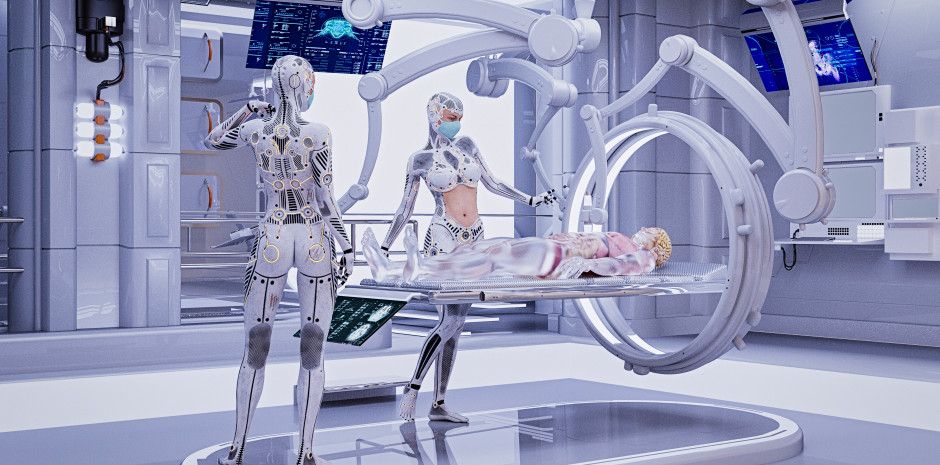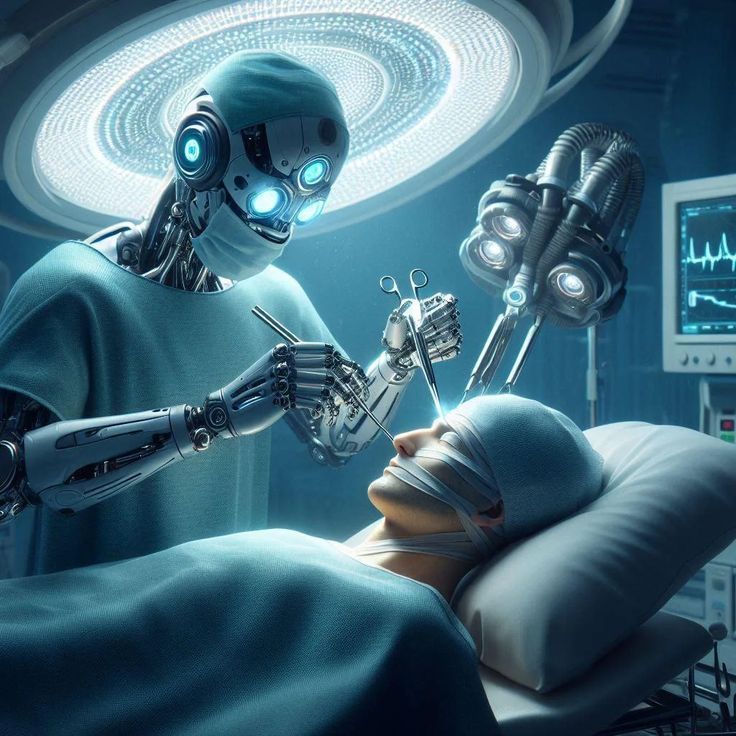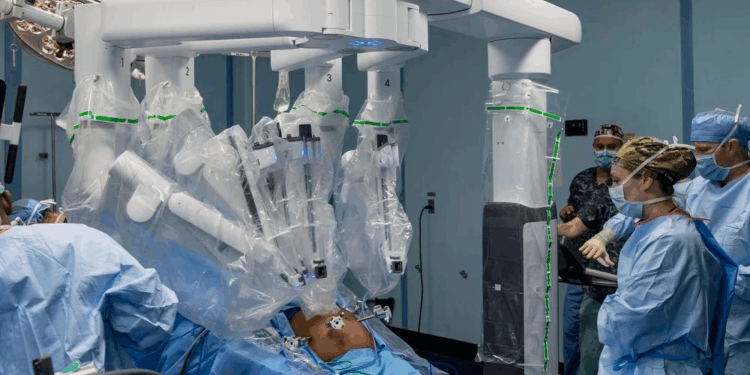Robotics Surgery: The Future of Precision Healthcare
The operating room is no longer solely the domain of human hands. Robotics surgery, once a concept confined to science fiction, is now a powerful reality, fundamentally reshaping the future of healthcare. It represents the pinnacle of medical technology, merging human surgical expertise with the unparalleled precision, dexterity, and stability of advanced robotic systems. These machines are not replacing surgeons; they are augmenting them, enabling minimally invasive procedures that were previously impossible, leading to better patient outcomes, faster recovery times, and ultimately, a transformation of surgical standards across the globe.
The advent of surgical robotics is a direct response to the persistent challenges in traditional surgery: limited visibility in closed body cavities, the physiological limits of human motion, and the inevitable fatigue inherent in long, complex procedures. By filtering tremors, scaling movements, and providing high-definition, three-dimensional (3D) visualization, robotic systems offer a level of control and accuracy that traditional open or even standard laparoscopic surgery cannot match. This revolution is creating a high-value niche in the medical field, making it a critical area of growth and a prime topic for long-form, expert SEO content aimed at a high-intent audience.
This exhaustive, 2000+ word article delves into the technological backbone of robotic surgery, explores its current applications and limitations, and forecasts the exciting trajectory of this field, making a compelling case for why robotic assistance is not just an optional tool, but the mandatory future of complex surgical care.
The Technological Core: How Robotic Systems Work
Modern robotic surgical systems are highly sophisticated, teleoperated machines. They operate on a master-slave principle, where the surgeon controls the movements from a console (the master), and the robotic arms inside the patient (the slave) replicate those movements with enhanced precision.
Key Components Defining Surgical Robotics
The efficacy and precision of robotic surgery stem from several integrated technological components working in concert:
A. The Surgeon Console (Master System): This is the command center where the surgeon sits comfortably, viewing the surgical field through a high-resolution, stereoscopic (3D) display. The surgeon manipulates master controllers (joysticks) that translate their hand, wrist, and finger movements into precise, filtered actions by the robotic instruments. Key features include:
- Ergonomic Design: Reduces surgeon fatigue, which is a major factor in traditional long surgeries.
- Force Feedback (Haptic Technology): Though still developing, haptic feedback allows the surgeon to feel the resistance and texture of the tissue they are working on, adding a vital layer of tactile control.
- Motion Scaling and Tremor Filtration: This core feature scales down the surgeon’s movements (e.g., a 1-inch hand movement might translate to a 1mm instrument movement) and automatically cancels out any physiological hand tremors, ensuring flawless accuracy.
B. The Patient-Side Cart (Slave System): This component is positioned over the patient and houses the robotic arms. It is the execution module that performs the actual surgery.
- Articulated Instrument Arms: Typically three or four arms are used, holding endoscopic cameras and surgical instruments. They are meticulously designed to move through small incisions.
- Endowrist Technology: The most revolutionary aspect. These instruments mimic the dexterity of the human wrist but with seven degrees of freedom (more than the human wrist), allowing for complex maneuvers, suturing, and knot-tying in confined spaces with greater range of motion and articulation than the human hand.
C. High-Definition 3D Vision System: The camera arm provides the surgeon with an immersive, magnified 3D visual field. This stereoscopic view is far superior to the flat, 2D image of traditional laparoscopy, enhancing depth perception and spatial awareness, which is critical for complex tissue dissection and delicate repair work. The high magnification also allows the surgeon to see minute structures, further improving precision.
Current Applications and Clinical Advantages
Robotic surgery has moved from experimental status to standard-of-care across numerous medical specialties. Its minimally invasive nature is the source of its most significant patient benefits.
Major Surgical Specialties Transformed by Robotics
The use of robotic systems is most prevalent and impactful in fields requiring fine motor control and operating in deep, difficult-to-access anatomical areas:
A. Urology (Prostatectomy and Nephrectomy): Robotic radical prostatectomy is now often the standard technique for prostate cancer removal. The system’s ability to operate in the deep, narrow pelvic cavity with superior visualization and articulation allows surgeons to meticulously preserve delicate nerves essential for urinary and sexual function, leading to significantly improved quality-of-life outcomes post-surgery.
B. Gynecology (Hysterectomy and Myomectomy): Robotics allow for complex procedures, such as the removal of large uterine fibroids (myomectomy) or total hysterectomy, to be performed through tiny incisions. This translates directly to less blood loss, less post-operative pain, and a return to normal activities days sooner than with traditional open surgery.
C. General Surgery (Colorectal and Hernia Repair): The dexterity of robotic arms enables highly precise bowel resections, which are crucial in colorectal cancer surgery. It also provides advantages in complex abdominal wall reconstruction and hernia repair, leading to lower complication rates and stronger, more durable repairs.
D. Cardiac Surgery (Mitral Valve Repair): Robotics allows for minimally invasive access to the heart for procedures like mitral valve repair, avoiding the necessity of a large sternotomy (cutting the breastbone). This dramatic reduction in incision size leads to faster healing and significantly less trauma to the patient’s chest cavity.
Key Patient Benefits Over Traditional Surgery
The clinical advantages of robotic-assisted surgery directly translate into tangible benefits for the patient, fueling its rapid adoption:
A. Reduced Post-Operative Pain and Medication Use: Smaller incisions mean less tissue trauma and muscle damage. This dramatically lowers the patient’s pain levels, reducing the need for powerful opioid painkillers and aiding faster, safer pain management.
B. Shorter Hospital Stay and Faster Recovery: Patients undergoing robotic procedures typically spend less time recovering in the hospital—often a matter of days rather than a week or more. The faster healing process allows them to return to work and daily activities much sooner, a massive economic and personal benefit.
C. Minimally Invasive Scarring and Improved Aesthetics: The procedures are performed through several small “keyhole” incisions (typically 8mm to 12mm), resulting in significantly smaller and less noticeable scars compared to the large incisions of open surgery.
D. Lower Risk of Infection and Blood Loss: The smaller surgical site minimizes exposure of internal organs to the outside environment, leading to a reduced risk of surgical site infections. Precise instrument control and superior visualization also contribute to less blood loss during the procedure.
 Challenges and Economic Considerations
Challenges and Economic Considerations
Despite its impressive advantages, the widespread adoption of robotic surgery faces significant hurdles related to cost, training, and logistical complexity. Addressing these challenges is vital for making the technology universally accessible.
High Initial Investment and Operational Costs
The financial outlay required to implement a robotic surgery program is substantial, creating a barrier for smaller hospitals and healthcare systems in developing nations.
A. Capital Equipment Cost: The initial purchase price of a primary robotic surgical system is exceptionally high, often exceeding $1.5 million to $2.5 million. This massive capital expenditure requires a high volume of procedures to achieve a positive return on investment.
B. Consumables and Maintenance: Robotic systems require ongoing, expensive consumables. Many instruments have limited use cycles (e.g., 10 uses) before they must be replaced, adding a significant per-procedure cost. Furthermore, annual maintenance contracts and servicing fees are mandatory and costly, increasing the hospital’s overall operational expenses.
C. Training and Credentialing: Surgeons and surgical teams must undergo extensive, specialized training to become proficient. This process requires significant time investment, simulations, and proctored cases, all of which add to the indirect cost of implementation. Hospitals must also establish rigorous credentialing standards to ensure patient safety.
The Learning Curve and Skill Acquisition
The transition from open or laparoscopic techniques to robotic surgery involves a steep learning curve for the entire operating room (OR) team.
A. Team Coordination and Efficiency: Successful robotic surgery requires perfect coordination between the console surgeon, the bedside assistant, the anesthesiologist, and the circulating nurse. The initial learning phase can lead to longer operative times as the team adjusts to the new workflow, which can slow down OR turnover and increase costs.
B. Lack of Haptic Feedback: While advanced systems are incorporating haptics, most current robotic systems lack true tactile feedback—the surgeon relies entirely on visual cues to gauge tissue tension and pressure. Overcoming this limitation requires significant practice and is a key area of development for future systems.
The Future Trajectory: AI, Miniaturization, and Autonomy
The current generation of robotic systems is merely the starting point. The next decade promises even more radical advancements driven by AI, smaller form factors, and increased automation.
Integrating AI for Enhanced Performance
The convergence of robotics with Artificial Intelligence (AI) and Machine Learning (ML) will unlock new levels of precision and safety.
A. Predictive Guidance and Real-Time Imaging: AI algorithms, trained on millions of hours of surgical video, will provide real-time cognitive assistance to the surgeon. For example, AI can analyze tissue images in real-time, overlaying virtual boundaries to prevent cutting critical structures like nerves or blood vessels, or identifying subtle cancerous margins invisible to the human eye.
B. Autonomous Surgical Tasks: While full autonomy is a distant prospect, ML will allow robots to autonomously perform smaller, repetitive, and high-precision tasks. This includes automated knot-tying, tissue cutting along a pre-defined path, or continuous stabilization of the surgical field, allowing the surgeon to focus solely on critical decision-making.
C. Pre-operative Planning and Simulation: AI and robotics will fully integrate with pre-operative imaging (CT, MRI) to create patient-specific surgical maps. Robots will then guide the instruments along the optimal, pre-planned path, further reducing variability and risk. Advanced simulation will also be used to train surgeons with personalized anatomical models derived from their actual patients.
Advancements in Accessibility and Functionality
Future developments aim to make robotic surgery more accessible, more flexible, and less dependent on massive infrastructure.
A. Single-Port and Miniaturized Systems: The industry is moving toward single-port robotics, where the entire procedure is performed through a single, small incision, further reducing patient trauma and scarring. Additionally, the development of smaller, modular, and even disposable robotic systems will reduce the cost and size, making them viable for smaller clinics and ambulatory surgery centers.
B. Remote and Telesurgery: Enhanced connectivity (like 5G and future networks) is making telesurgery—performing an operation on a patient miles away—more reliable. This technology has profound implications for global healthcare access, allowing highly specialized surgeons in urban centers to treat patients in remote or underserved rural areas, democratizing high-quality care.
C. Soft Robotics and Compliant Systems: The next wave of robots will utilize soft robotics, materials that are flexible and compliant, allowing the instruments to navigate and manipulate delicate organs with less risk of damage than current rigid tools. This is particularly promising for neurosurgery and procedures within the complex vasculature.
 Conclusion
Conclusion
Robotic surgery is not a futuristic novelty; it is a present-day necessity driving a new era of surgical precision and safety. The compelling clinical benefits—shorter recovery times, less pain, lower infection rates, and superior functional outcomes—create an undeniable mandate for its integration into modern healthcare infrastructure.
While the financial barrier to entry remains high, the cost will inevitably decline as competition increases and technology matures. The true long-term value lies in the reduction of surgical complications, the decrease in hospital readmissions, and the accelerated return to productivity for patients—all of which translate into massive savings for healthcare systems and society as a whole.
The future of surgery is inextricably linked to the capabilities of intelligent robotic systems. Healthcare professionals must invest not only in the machines themselves but also in the rigorous training and logistical protocols necessary to harness their full potential. By doing so, they secure a future where complex surgical care is defined by unmatched accuracy, minimal invasion, and optimized patient recovery.












